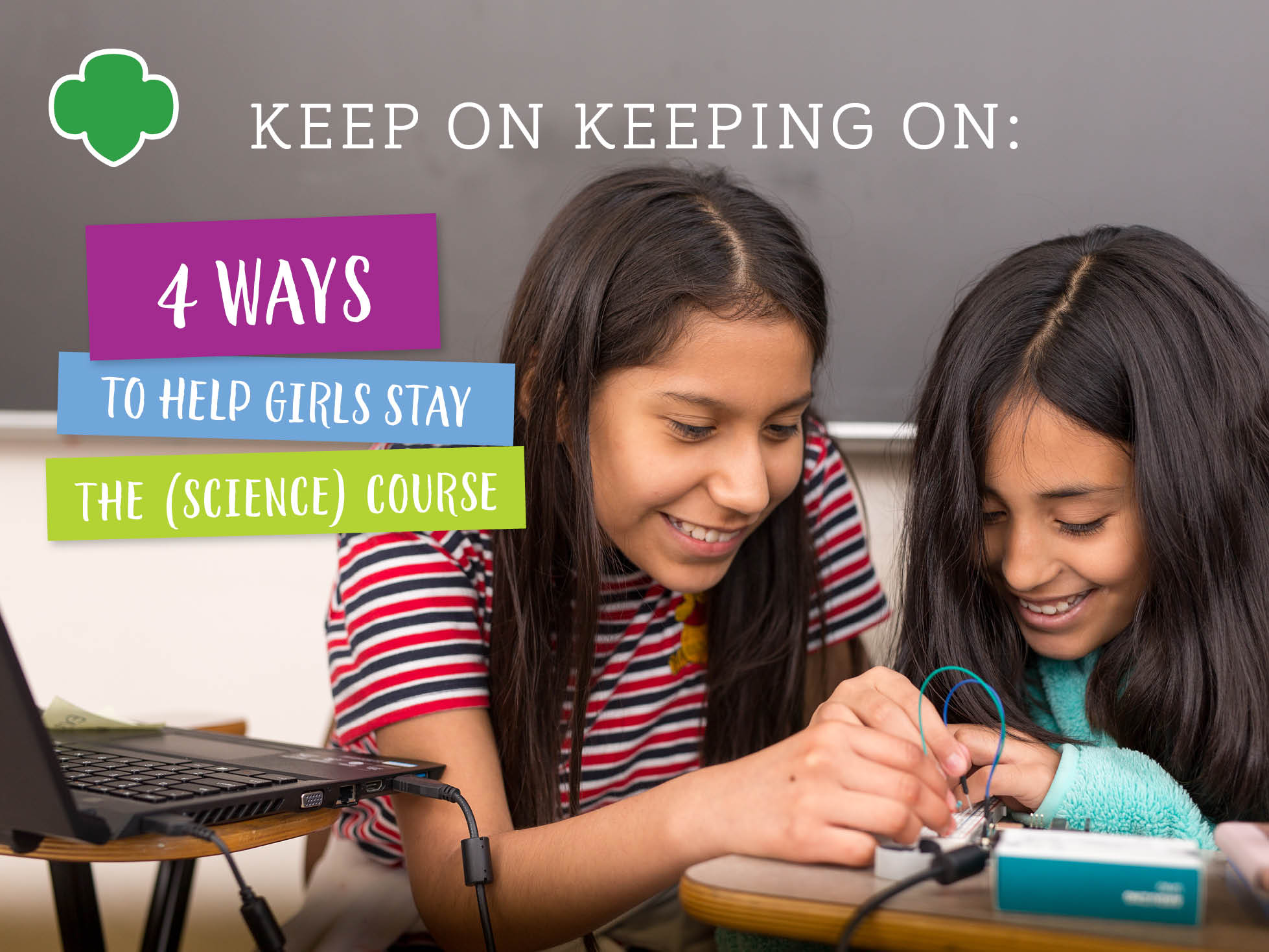 Recently, I had the pleasure of representing Girl Scouts at the Society of Women Engineers National Conference. During the conference, a topic that kept coming up among parents, educators, and other girl-supporters was the question of how to keep elementary-aged girls who were already engaged in science and engineering to continue these pursuits as they get older.
Recently, I had the pleasure of representing Girl Scouts at the Society of Women Engineers National Conference. During the conference, a topic that kept coming up among parents, educators, and other girl-supporters was the question of how to keep elementary-aged girls who were already engaged in science and engineering to continue these pursuits as they get older.
Here at Girl Scouts River Valleys, we know that there are unfortunately many subtle (and not-so-subtle) messages that can discourage girls from exploring topics in STEM that interest them. That’s why a supportive parent or troop leader can make a huge difference in their continued engagement in topics they care about. Read on for my top tips for keeping girls interested and engaged in STEM, especially after third grade.
Keep it Hands-on
As girls get older, the hands-on engagement with science may shrink depending on their school environment. It is very common for early elementary science to be filled with experiments and exploration, but that can diminish as students get older and concepts become more theoretical. This can cause a dip in overall interest in STEM topics—because we know from research about girls that they learn best through hands-on experiences!
Luckily, Girl Scouts provides a great framework and lots of resources to keep doing hands-on STEM experiences as girls get older. You can work toward one of the new STEM badges or Journeys in the Volunteer Toolkit, which comes with meeting plans to make it easy for you and the girls to lead. You can also attend council events and get access to exclusive Girl Scout opportunities with great experiential learning, while meeting new girls from all over Minnesota, Wisconsin, and Iowa!
Connect Girls with Female Role Models
You can’t be what you can’t see! Girls can lose interest in STEM quickly if they are only seeing male scientists in media, news, and even classes in school. Luckily there are lots of great resources to connect girls with role models who look like them and know what it’s like to grow up as a girl.
You can learn about role models online through SciGirls. Each Role Model profile features a different type of STEM professional—including some you may not have thought of like bicycle engineer, carpenter, and octopus trainer (Who knew?).
You can also attend council events for STEM, which often feature women in science. They may be architects, engineers, programmers, or nuclear scientists!
Connect Their Current Interests with Science and Technology
Girls (and troop leaders) have a lot of interests that they might not even realize are connected to science, engineering, or technology. For example, many girls I’ve met through Girl Scouts are interested in cooking. While cooking is all about chemical reactions, you can even take it past kitchen science and into the lab. (E.g., Did you know that when a company decides to make a new chip flavor, they have a team of chemical engineers that work together to create the “dust” that makes your chips taste like BBQ, sour cream and onion, or dill pickles?)
Many girls also love to use apps or play games on phones and tablets. This is connected to computer science and programming. You can build on girls’ interest by asking, “If you could design an app for your phone, what would you create?” This simply shifts the conversation from consumption to production and help girls realize that they could be the ones who create the apps and games of the future.
Dispel Myths About STEM Careers
There is, unfortunately, a lot of misinformation about what working in science, technology, or engineering fields is like. Because of historical narratives and media tropes, many girls may feel alienated by STEM careers because they think they need to be a super genius who works alone in their basement, coding all day without seeing the sun. This stereotype is not true! There’s no need to be a singular super-genius, because scientists, engineers, and programmers always work in teams. Working in these fields involves a lot of creativity, and often means creating solutions to make people’s lives better and the world a better place.
There are plenty of good reasons to keep girl’s interest in STEM high as they get older. We know from our research at Girl Scouts that girls who are interested in STEM do better in school, try more new things, and persist more easily through failure. So even if she doesn’t choose a science or technology career later in life, her experiences in STEM as a girl will set her up for success—and help her have a ton of fun with her troop!
 Hannah Gilbert – Hannah is the STEM Program Coordinator and Summer Camp Director of Camp Lakamaga at Girl Scouts River Valleys. She also co-leads a troop of passionate, hilarious Girl Scout Juniors. Hannah has a degree in anthropology and environmental studies from New College of Florida. She’s worked in youth development continuously since high school and has spent over five summers at one camp or another. Her favorite activities to do with girls are open-ended, messy, and collaborative! Hannah lives in Minneapolis with her husband and their six-pound rescue dog. She loves to play video games and go hiking. She’s also a big movie fan—Hannah and her husband watch at least two movies a week!
Hannah Gilbert – Hannah is the STEM Program Coordinator and Summer Camp Director of Camp Lakamaga at Girl Scouts River Valleys. She also co-leads a troop of passionate, hilarious Girl Scout Juniors. Hannah has a degree in anthropology and environmental studies from New College of Florida. She’s worked in youth development continuously since high school and has spent over five summers at one camp or another. Her favorite activities to do with girls are open-ended, messy, and collaborative! Hannah lives in Minneapolis with her husband and their six-pound rescue dog. She loves to play video games and go hiking. She’s also a big movie fan—Hannah and her husband watch at least two movies a week!